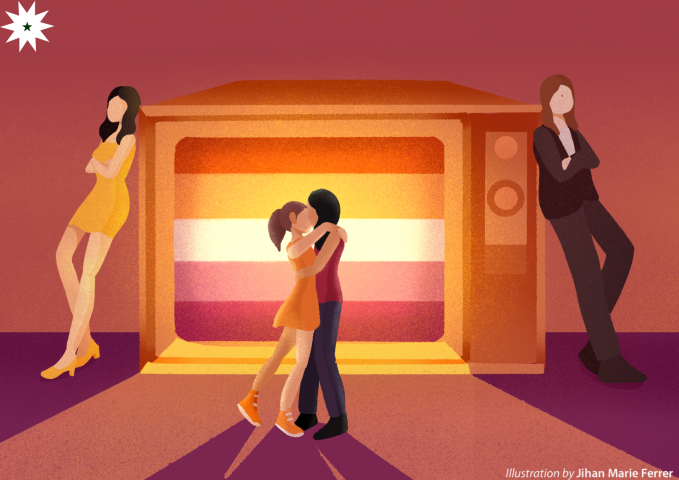
In recent years, we have witnessed the rise of LGBTQ+-themed content in media, with titles such as Love, Simon; God’s Own Country; and Moonlight raking in commercial and critical success. It seemed as if, finally, the community was getting the representation that it deserved. The same can be said for the local film scene, with Gameboys and Gaya sa Pelikula ushering in a new era of queer representation in the country.
However, one glaring fact remains—in the Philippines, LGBTQ+ representation in media largely focuses on male homosexual love, while queer female stories are few and far in between. Filipino sapphic or Girls’ Love (GL) shows have yet to see a rise in the way that the Boys’ Love (BL) genre has experienced.
While BL’s popularity is certainly one to be celebrated, sapphic women deserve to have their stories told in the same way, to have their time to shine under the spotlight. And this is precisely what Rachel Coates and Keavy Eunice Vicente aim to do.
Leading the charge
“When I was growing up, I didn’t see a lot of queer women on screen,” recounts Keavy Eunice Vicente, writer of the recently concluded GL show, Pearl Next Door. The lack of representation meant that a lot of queer women didn’t get the chance to see themselves on the big screen, to see someone just like them in the fairytales and love stories of generations past, which is why Vicente so eagerly jumped at the opportunity to join the show’s creative team. “I got really excited. I just really wanted the young, queer women of today to have characters that they can relate to. I just want them to feel seen,” she shares.
Rachel Coates portrays Alex Aguirre—one of Pearl’s love interests. For Coates, the prospect of playing a lesbian character in a GL was a chance at giving sapphics better representation. “She’s somebody I would have loved to have seen growing up as a queer kid,” she enthusiastically says of her role, noting that it was empowering to see a confident lesbian character that was past the hurdle of comeling to terms with her sexuality—a refreshing break from the stereotypical portrayal of queer women from the 90s and early 2000s. “I knew how to be tortured; I didn’t know how to be happy,” she expresses.
Similarly, Vicente started the show with the idea of authentically portraying sapphic love—warts and all. “I wanted them to see themselves on-screen in characters that are strong, beautiful and flawed,” she declares.
Challenges abound
Although representation matters, many portrayals of female queerness often end up being a disservice as queer characters are reduced to sexual objects, tragic endings, or cheap punchlines. To erase these harmful stereotypes, change must start from behind the camera.
While two out of three of Pearl Next Door’s directors—Ivan Andrew Payawal and Perci Intalan—are gay men, they cannot speak on behalf of queer women. As such, the team behind the show were keen on casting queer women, like Coates and Iana Bernardez, who plays Karleen, another one of titular character Pearl’s love interests. Moreover, the cast also attended a sexual orientation and gender identity expression workshop by Babaylanes Inc. headed by gender equality advocate Atty. Claire de Leon.
While media often constrains women into two-dimensional roles of Playboy bunnies or overly emotional maidens, the show took care to frame female pleasure in a positive light, establishing that women’s sexual desires are healthy and empowering.
Coates could not be prouder of the show’s treatment of female sexuality, saying, “I’m happy that Pearl Next Door addressed it…I just feel like in sapphic media, whatever the sexual aspect tends to take a backseat, compared to the emotional aspect.”
Humanized
However, Pearl Next Door was not without its flaws, many of which the fans were quick to criticize. For one, the story pitted women against each other by using a love triangle to make Karleen and Alex compete for Pearl’s love as if she was a prized trophy to be won.
Coates addresses this, acknowledging, “While [Alex] acknowledged it, it’s still pitting woman against woman. That’s something that we’d like to not deal with in the future of Girls’ Love series. We don’t want to make it a benchmark or a precedent for the future either.”
Another criticism is the toxic relationship between Karleen and Pearl, played by Adrianna So. Karleen—a lesbian—initially refused to be in a relationship with Pearl, as she swore to quit dating bisexual women due to traumatic experiences with previous partners.
On this, Coates intimately reflects, “Pearl’s journey was realistic. Just because they’re lesbians doesn’t mean they can’t be toxic as well. But there are healthy relationships to be had, and that’s something I’ve had. That’s the story I’d love to tell in the near future.”
First steps
For Coates, the criticism only highlighted just how much the audience truly wanted a proper Girls’ Love show, one that paralleled or even exceeded the authentic representation of what Boys’ Love was granted because sapphic representation is every bit as important.
Vicente asserts, “Since we are one of the first GL shows in the country, we knew going into this that there will be birthing pains. But we also knew from the start that this is a story that we wanted to tell.”
As Philippine BL took a long time to arrive, there’s an equal if not more promising future for stories that personify sapphics, achieving their right and freedom to live a happily-ever-after. While there’s still a way to go, Pearl Next Door has ignited the proverbial torch—lighting the way for a better, more authentic portrayal of Girls’ Love.
The best art is a protest for human rights, fighting for equity and progress. Coates expresses, “Art is nothing if it’s not human, and if it doesn’t connect with humanity, then it’s not really anything, is it?”
